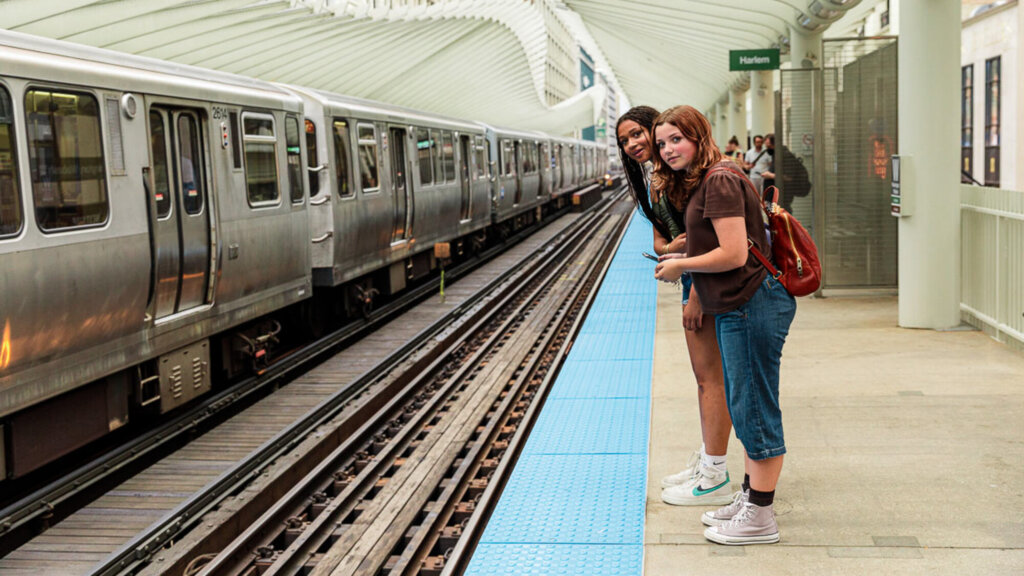Plan of Action for Regional Transit
The Chicago region is defined by transit
The city of Chicago was built around our iconic elevated railway. Suburban riders rely on Metra to connect them to destinations for work and play. Many communities were developed around transit stations. A robust network of buses crisscrosses the region. Transit takes residents to and from jobs, doctors’ appointments, parks, shopping and visits with loved ones. It creates a healthier region on many levels. A metro area of our size and density simply could not exist without public transportation. And yet the future of this vital infrastructure hangs in the balance.
We have less service on the street than before the pandemic, and service was trending down for more than a decade before that. Our bus fleets are too often snarled in car traffic. Staffing is an issue and public perception of the rider experience remains stubbornly low. The system needs reinvestment and reimagining to survive.
Key Resources
- Geographic Equity of Transit Service
- An Urban Core Congestion Pricing Program for the Chicago Region
- Visualizing Service Cuts With StoryMaps: Background & Methodology
- The Future of Transit in Northeastern Illinois (StoryMaps)
- Urban-Suburban Transit Fare Comparison
- Advancing Transit-Supportive Development in Chicago-area Suburbs
- Poor Prospects for RTA Proposed Reforms
- How does the RTA’s transit reform proposal align with the PART recommendations?
- The transit governance model in Chicago: an outlier
- Taking PART in the region’s transit governance conversation
- A thriving region requires public transit
- How riding public transit helps save the penguins
- Strong Transportation Policy is Key to Supporting Illinois Workers
- 1994 Mobility for Metropolitan Chicago report by the Metropolitan Planning Council (MPC)
- 2007 Performance Audit: Mass Transit Agencies of Northeastern Illinois, March 2007
- 2013 Northeastern Illinois Public Transit Task Force Report
- 2013 Determining the Equitable Allocation of Public Funding for a Regional Transportation System, Delcan Corporation
- 2023 Plan of Action for Regional Transit, Chicago Metropolitan Agency for Planning
- The Transit Governance Model in Chicago: An Outlier
- Metropolitan Mobility Act Bill Status SB0005 (Villivalam) – January 13, 2024
Re-introduction to Illinois General Assembly - Public Act 102-1028 SB3848 – required the Chicago Metropolitan Agency for Planning to make legislative recommendations for long-term stability of the transit system.
- Issue Brief: Metropolitan Mobility Authority Act (SB 3937) and Eminent Domain
- Metropolitan Mobility Act – SB 3937 (Villivalam) / HB5823 (Buckner) – April 29, 2024
- Legislative summary of Metropolitan Mobility Act
- Transit funding act SB3938 (Villivalam) / HB5828 (Delgado) – April 29, 2024
Debate over the future of CTA, Metra, Pace, RTA to heat up in Springfield this year
By Sarah Freishtat, Chicago Tribune
Published January 12, 2025
By Igor Studenkov, Streetsblog Chicago
Published June 19, 2024

An essential system at a critical juncture
The urgency could hardly be greater. A massive operations funding shortfall is looming. When ridership and revenue plummeted during the COVID-19 pandemic, the federal government stepped in to keep the system going. But that funding will sunset by 2025, leaving an operating budget hole of about twenty percent. In a post-COVID world, we need transit more than ever: to battle climate change, to address economic inequities, to improve public health, to reduce housing costs, and to improve the safety of travel.
Cutting service will not solve the funding problem. (PART Briefing Book May 2023, p. 45) The anticipated budget shortfall would require the region to cut 30 – 40 percent of transit service, basically collapse the system. We cannot allow this to happen when ridership is beginning to rebound and we need sustainable, affordable transportation options more than ever. Where do we go from here?
The call for governance reform has been coming for decades
The system faces challenges the current governance structure cannot address, many of which have been developing for years. When each transit agency (CTA, Metra and Pace) manages to its own bottom line, planning and budgeting occurs in silos. There is no single entity to connect the dots. Who’s looking for riders that need to transfer between services. What about an integrated farecard so riders pay only one fare for each ride? How do we determine regional investments will help the most riders?
We must adapt to post-pandemic travel patterns and other realities. We also know the Regional Transportation Authority does not have enough power to solve these problems. We know that our governance structure is an outlier nationally. We need to change the transit governance structure so that planning and project prioritization happen at a regional level, with an integrated and rider-centric perspective. Multiple studies have made that recommendation over the past decade:
![]()
A 1994 Mobility for Metropolitan Chicago report by the Metropolitan Planning Council (MPC) resulting from a regional task force convened in June 1993 and funded by the RTA, said “financial restructuring and service expansion are more likely to succeed if the region tackles three difficult issues that contribute to the current mobility problems:
- Land use should support transportation investments
- Public funds for transportation should provide incentives to achieve regional goals
- Regional governance structures should be reworked to be more responsive to changing transportation needs.”
![]()
A 2007 report by the Office of the Illinois Auditor General concluded: “The General Assembly may wish to consider several statutory changes to address mass transit in northeastern Illinois:
- Change the Governance Structure. Such changes could range from enhancing the RTA, (e.g., planning, reviewing budgets, finance, coordination of fares, performance measurement and oversight of operations) to centralizing governance.
- Review the funding formula. Service boards are funded by sales taxes that are distributed by statutory formula, which has remained unchanged since its inception in 1983.
- Review the RTA Board membership. The current allocation of RTA board members is not consistent with the population distribution of the year 2000 federal census.”
![]()
The 2013 Northeastern Illinois Governor’s Task Force Report recommended:
- “Creation of a single integrated transit entity for the region.” The report provided an example of how the region might create a new governing board to replace RTA, CTA, Metra, and Pace, under which the service boards would become operating units.
- “Creation of a regional transit plan and develop regional performance measures to assess progress toward implementing the plan.”
![]()
The 2013 Delcan Report commissioned by the RTA concluded:
- “The current institutional and financial structure used for transit in Northeastern Illinois is flawed. The funding formulas are complex, out of date (some rules have been unchanged for thirty years), and rigid.
- RTA does not have the necessary authority to support the planning and decision-making process called for in current legislation (the RTA Act), resulting in an effort that is involved, argumentative, and often unproductive.
- No other major metropolitan region in the US has selected a similar institutional arrangement
- The current super majority requirement to approve financial plans and other key measures makes it possible for relatively small groups to exercise veto power over key decisions.”
![]()
The 2014 Eno Transportation Center report concluded:
- “Choose independence or choose consolidation—you cannot have both. Numerous interviewees in the Chicago region agreed that RTA either needs to be strengthened or eliminated. Either one would be preferable to the current situation where RTA is just strong enough to be an obstruction, but too weak to have any real planning influence over the region.
- It is shortsighted to have no state involvement in transit when transit has such a large impact on the economic success of the state.
- Having one entity holding the purse strings is a necessary, but not sufficient means of bringing regional transit entities together effectively.”
The Plan of Action for Regional Transit (PART)
Enter the Plan of Action for Regional Transit (PART). In 2022, the Illinois General Assembly approved Public Act 102-1028, tasking the Chicago Metropolitan Agency for Planning (CMAP) with developing legislative and policy recommendations for the future of the region’s transit system to prepare for the impending funding cliff and post-pandemic transit reform. CMAP’s 2023 PART report documented the weaknesses of the current governance structure, which it described as “layered and complex” and noted that “past recommendations made by transit advocates to increase regional coordination for planning, policy, and funding allocation remain unfulfilled.”
The PART Plan recommends centralized governance. In collaboration with other advocates, MPC has been actively engaged in turning the PART recommendations into legislative solutions. On April 29, the Metropolitan Mobility Act (SB3937 Villivalam/HB 5823 Buckner) was introduced. Here is a summary of the bill’s key provisions.
We must fund transit commensurate with its value
Governance changes must come in tandem with funding transit sufficiently. A Transit funding act to increase annual transit operations funding by $1.5B was introduced at the same time as the Metropolitan Mobility Act. This is in alignment with the PART report recommendation. However, the ultimate increased source(s) for sustainable transit operations funding are still being determined.

We can have better transit
To get the system we want, we need to fund it beyond just filling the gap to keep the system we have. We can achieve a vision of safe, welcoming transit that gets people where they need to go throughout the region, not only to downtown Chicago. This includes regional rail offering frequent Metra travel in both directions; better buses, in the suburbs and city, including bus rapid transit (BRT) and a network of Pace Pulse+; improved demand-responsive services; and transit-supportive land use and development.
Investing in transit will support new travel patterns required in a post-COVID world and enable the growth and vibrancy of our region going forward. We can modernize our transit system for a sustainable future where we are prepared to adapt and innovate. Other cities have recognized the long-term value of transit and are working hard to build out the kind of network we take for granted.
To have the future we want, — more money freed up in our household budgets; less stressful and dangerous travel; healthy air; better access to jobs, healthcare, and education; and slowing down the climate crisis – we must have the courage to reinvent and reinvest in transit. We need to turn the page on chronic underfunding of our most sustainable and equitable form of transportation. Now is the time.

